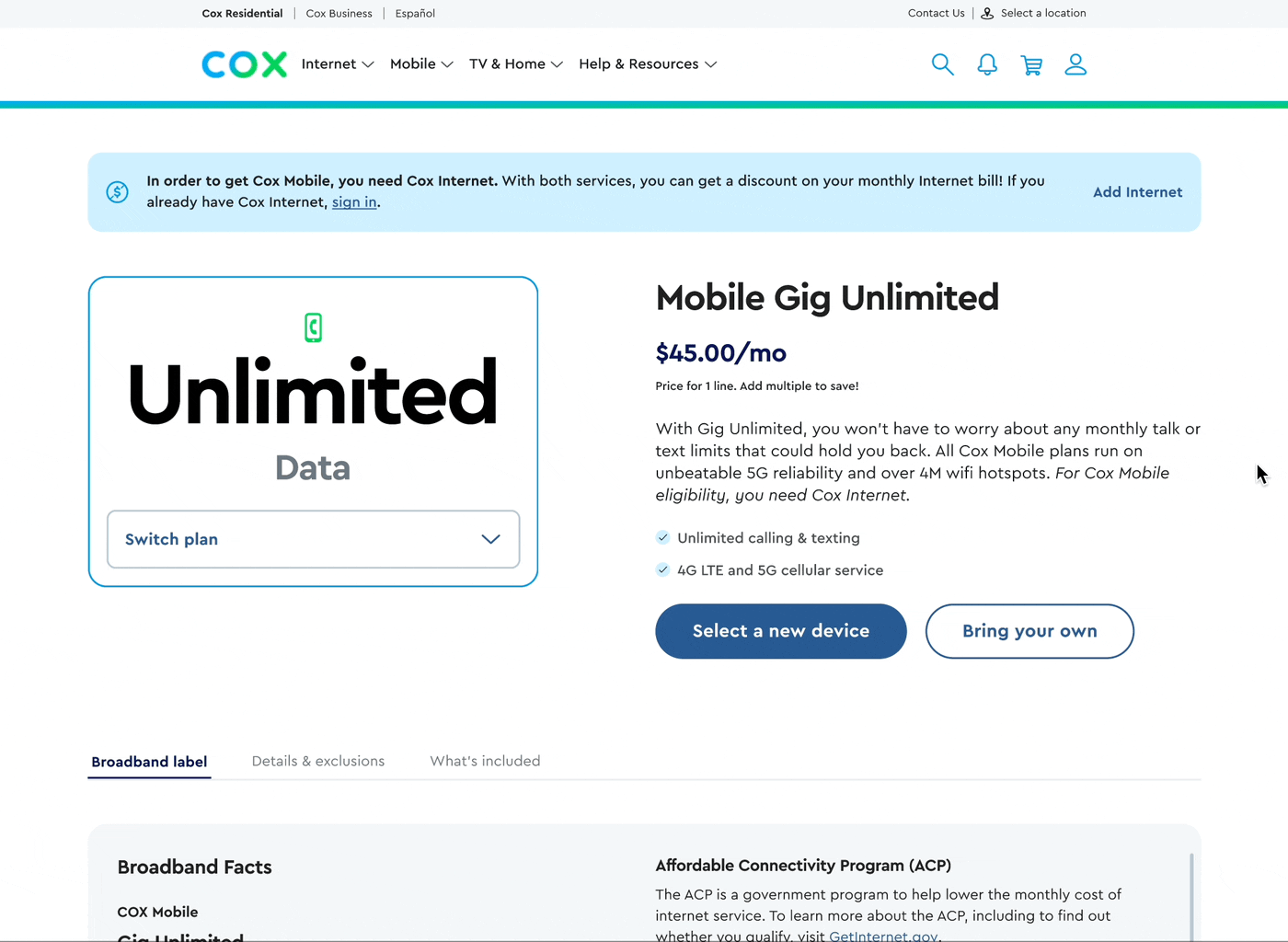
OVERVIEW
Setting a new industry standard for Internet + Mobile e-commerce and driving emerging product sales
We were asked to design a unified configuration-through-purchase flow for Cox's emerging Internet + Mobile offerings. Our team took this as an opportunity to set a new ISP industry standard that drives multi-service sales. To do so, we introduced product detail pages, radically streamlined configuration, and launched a true shopping cart on cox.com for the first time.
These changes are still in active development with key release milestones in April, July and September 2023. We have forecasted a 77% increase in average monthly Mobile Wireless (6X increase in new customer sales) and a 25% increase to average monthly Internet sales through the digital channel.
RESPONSIBILITIES
User flow oversight
Wireframes
Requirements gathering
Required states and scenarios definition
Narrative for client reviews
Functional annotations for delivery
TEAM
Abby Reimer & Rachel Schwartz: Product Management
Xiaoyu Liu: UX Design
Leigh Watson & Zoe Wang: Visual Design
Zoe Sherlock: Project Management
Len Weimer: Research
TIMELINE
UX Strategy: 4 weeks
PDP Configurator: 4 weeks
Shopping Cart: 6 weeks
Checkout: 6 weeks
Phase 1 reach back: 6 weeks
AUDIT & BEACONS
Identifying problems and possible solutions
The team audited current state of Internet + Cox Mobile flows, analyzed in and out of category beacons, and formulated three experience principles to guide the team throughout the work. Those principles are 1) Simple, 2) Informative, and 3) Easy to use.




UX STRATEGY
Mapping ideal core flows and sub flows
Because combining Internet + Mobile shopping was new to Cox and the ISP industry, mapping the steps for a seamless experience was critical. Detailing the required differences between purchase steps and customer types (new vs. current) helped us ensure consistent UX/UI across.
Current customer
Current customers already have Cox Internet, so Internet plan selection and configuration is not part of their flow. Similarly, Internet PDP pages are deprioritized as entry points. Additionally, with Cox Mobile added, some current customers could get a faster Internet speed at no extra cost.

New customer
Internet selection and configuration is a required part of the new customer flow. This means that Internet PDP pages are important entry points. Additionally, new customers who start with Mobile need to be reminded of the Internet requirement in the right place at the right time and encouraged to action on it.

IMPLEMENTATION PLAN
Defining a release plan with Cox
Because of Cox’s ‘decision by committee’ culture, Huge took a hands on approach to defining a release plan rooted in impact forecasting. Our goal was to ensure that we’d solve the biggest customer problems asap and drive mid-term sales growth for all services, not just one.
From Conway’s Law
To Multi-channel coordination
From narrow focus on current customer sales
To scalable solutions that drive multi-service sales
From short term hacks
To iterative solutions that build toward the ideal customer experience
From how to buy
To why to buy
CRITICAL OPPORTUNITIES
Aligning on phase 1 priorities
For phase 1 release, maintaining some live site look, feel, and functionality became important for tech bandwidth and limitations. We put the most design effort towards the opportunities that would have the biggest business and customer impact.
Introduce plan details pages
Give product details room to breathe and let users navigate directly to them.

Streamline configuration
Cut new customer steps to purchase down by more than 100% and reduce repeat information entry.

Establish a true shopping cart
Use familiar patterns to meet user expectations (one page for all services).

Revamp global navigation
Make the IA reflect new Internet + Mobile priorities and modernize the UX/UI.

ADDITIONAL REQUIREMENTS
Diving deeper into requirements
Throughout the design process, we had regular working sessions with our clients to dive deeper into their feedback, ask clarify design questions, review options, and talk through edge cases. These conversations directly informed the states we’d need to include in delivery.

RESEARCH
Testing the designs for usability
The team rated the severity of each finding (high, medium, low, FYI, or positive) and determined whether a design change needed to be made accordingly. Users generally found the site clean and easy to use, and they liked the level of detail that was provided about fees.

FINAL DESIGNS
Detailing steps, screens, and states
We organized our delivery file according to 4 core flows with annotated connectors and a happy path prototype for each. The multitude of edge cases and conditional states that weren't part of those happy paths were delivered as static screens (also in flow order).

RESULTS
Getting feedback from our clients
While we continue to partner with our clients throughout the product development cycle, our team’s approach, which balanced forward-thinking pushes and pragmatic prioritization, helped our clients solve a longstanding and complex challenge.
“I appreciate your continuing to push us (and our experiences) out of our comfort zone. Now you can say told you so.”
- Cox’s Director of UX

